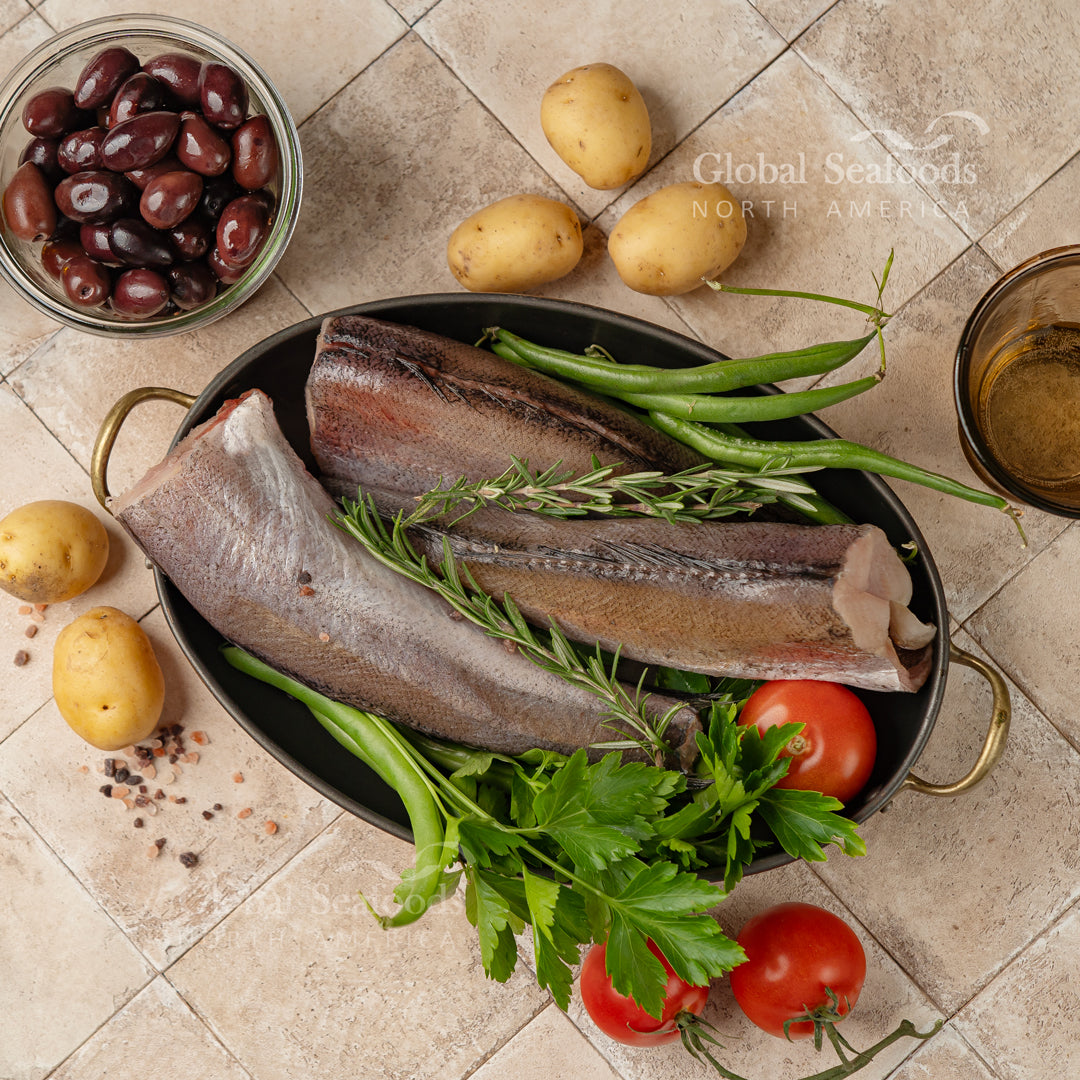Hake vs Cod: A Comparison of Taste, Texture, and Nutrition

Hake vs Cod: Which One Is Right for You?
When deciding between hake and cod, understanding their differences in taste, texture, nutrition, and versatility can help you choose the best fish for your recipe. Both are popular whitefish known for their mild flavors and health benefits, but they each bring unique qualities to the table.
This comprehensive guide provides detailed answers to frequently asked questions and highlights why hake and cod are excellent choices for seafood lovers.
Taste and Texture: Hake vs Cod
Hake:
- Taste: Hake offers a mild, slightly sweet flavor that is subtle and clean, making it ideal for light and healthy dishes.
- Texture: Delicate, flaky, and tender. Its soft texture is perfect for steaming, baking, and grilling.
Cod:
- Taste: Cod has a firmer, meatier texture with a mild but slightly savory flavor. It holds up well in hearty dishes and recipes requiring frying or heavy seasoning.
- Texture: Firm, dense, and ideal for frying in batter, making it a popular choice for fish and chips.
Chef’s Quote: "If you want a fish that melts in your mouth, go for hake. Cod, on the other hand, is great for robust, filling dishes," says Jamie Oliver.
Nutrition: Is Hake Healthier Than Cod?
Both hake and cod are nutritious, but their profiles differ slightly:
Hake Nutrition:
- Calories: Lower in calories compared to cod, making it a great choice for weight management.
- Fat: Very low in fat, particularly saturated fat.
- Protein: A high-quality source of lean protein.
- Omega-3 Fatty Acids: Promotes heart and brain health.
- Vitamins and Minerals: Rich in B12, selenium, and phosphorus for overall health.
Cod Nutrition:
- Calories: Slightly higher calorie count, which can provide more energy.
- Fat: Low in fat but slightly higher than hake, making it slightly richer in flavor.
- Protein: High protein content supports muscle growth and repair.
- Omega-3 Fatty Acids: Similar to hake, cod provides essential fatty acids for heart health.
Health Tip: Hake is a better choice if you’re watching calories or aiming for a very lean source of protein, while cod provides more bulk for filling meals.
Best Uses for Each Fish
Hake:
- Grilled: Perfect for a smoky, light flavor paired with citrus or herbs.
- Baked: Ideal for a quick, healthy dinner. Add olive oil, garlic, and parsley for a Mediterranean twist.
- Stews: Hake’s delicate texture works beautifully in light broths and tomato-based stews.
Cod:
- Fried: Cod’s firm texture makes it the go-to choice for fish and chips.
- Baked: Cod holds its shape well, making it great for casseroles and cheesy fish pies.
- Soups: Cod adds substance to hearty chowders and soups.
Hake vs Cod: Substitutions
Can You Substitute Cod for Hake?
Yes, cod can substitute for hake in most recipes, though the texture and flavor may vary slightly:
- In Grilled Dishes: Hake is softer and more delicate, so adjust cooking times to prevent overcooking when substituting cod.
- In Stews: Both fish work well, but cod adds more density.
- For Frying: Cod’s firm texture makes it a better choice for deep frying.
Affordability: Is Hake a Cheap Fish?
Yes, hake is generally considered an affordable fish. Its abundance, particularly in Atlantic and Pacific waters, helps keep prices low. Cod, on the other hand, is slightly more expensive due to its higher demand and limited availability in some regions.
Pro Tip: For budget-friendly seafood meals, opt for hake fillets or explore other affordable options like pollock or haddock.
Backlinks for Fresh Fish:
Bones: Does Hake Have Lots of Bones?
No, hake has relatively few bones, and most commercially sold hake fillets are deboned, making it easy to prepare and eat. Whole hake may require some effort to debone, but the bones are soft and easily removed.
Mercury Levels: Is Hake High in Mercury?
Hake is considered a low-mercury fish, making it a safer seafood choice for pregnant women, children, and those who need to monitor their mercury intake.
Common Cooking Issues: Why Is My Hake Mushy?
Hake can become mushy if improperly cooked or thawed:
- Improper Thawing: Always thaw frozen hake in the refrigerator overnight. Avoid quick-thawing methods like microwaving, as they compromise texture.
- Overcooking: Hake’s delicate texture means it cooks quickly. Overcooking can make it fall apart or feel mushy. Aim for 10-12 minutes at most.
Flavor Profile: Does Hake Have a Fishy Taste?
No, hake is known for its mild, slightly sweet flavor. It’s less "fishy" than other species, such as mackerel or sardines, making it a great option for those who prefer subtle seafood flavors.
How to Remove Fishy Taste from Hake:
- Milk Soak: Soak hake fillets in milk or buttermilk for 15-20 minutes before cooking. This neutralizes odors and enhances the fish’s natural sweetness.
- Use Citrus: Marinate hake with lemon or lime juice to brighten its flavor and eliminate any unwanted fishiness.
What Is Hake Called in the USA?
In the United States, hake is commonly referred to as Pacific Hake or Pacific Whiting (Merluccius productus). These terms are interchangeable and describe the same species, sustainably harvested along the Pacific Coast.
Backlink: Explore sustainably sourced Pacific Hake (Whiting).
Hake vs Cod: Which Is Better?
The choice between hake and cod depends on your recipe and preferences:
-
Choose Hake If:
- You prefer a light, delicate fish.
- You’re looking for a low-calorie, lean protein source.
- You enjoy grilled, baked, or stewed dishes.
-
Choose Cod If:
- You want a firm, meaty texture.
- You’re preparing fried fish or hearty recipes like chowders.
- You need a filling, energy-rich meal.
Chef’s Quote: "For light, healthy cooking, hake is a dream. But cod’s firm texture and versatility make it the king of fish fries," says Gordon Ramsay.
Conclusion
Both hake and cod are excellent seafood options with unique qualities. Hake stands out for its delicate texture, mild flavor, and affordability, while cod offers a firm, meaty alternative perfect for hearty dishes.
No matter which fish you choose, you can enjoy the benefits of a nutritious, versatile, and sustainable seafood option.
Watch Our Hake and Cod Comparison Video on YouTube:
Global Seafoods YouTube Channel
For more seafood options, explore:
Also in News

Columbia River Steelhead | Life Cycle, Conservation & Facts
Columbia River steelhead are one of the most resilient salmonid species, embarking on an incredible migration from freshwater to the ocean and back. Learn about their spawning habits, juvenile development, oceanic journey, and conservation efforts. Discover why steelhead are a prized fish for both anglers and seafood lovers.

Mastering Dover Sole: Cooking & Serving Guide for a Gourmet Experience
Dover Sole is a culinary delight known for its mild flavor and tender texture. Whether you're pan-frying for a crispy finish, baking for a healthy meal, or grilling for a smoky touch, this guide provides expert tips on preparing, cooking, and serving Dover Sole. Elevate your seafood dishes and enjoy gourmet flavors at home.

Cocktail Caviar Pairings: Best Drinks to Complement Exquisite Caviar
Pairing caviar with the right cocktail enhances both flavors, turning any occasion into an indulgent experience. Learn expert tips on pairing champagne, martinis, Moscow mules, and more with the perfect caviar selection.

